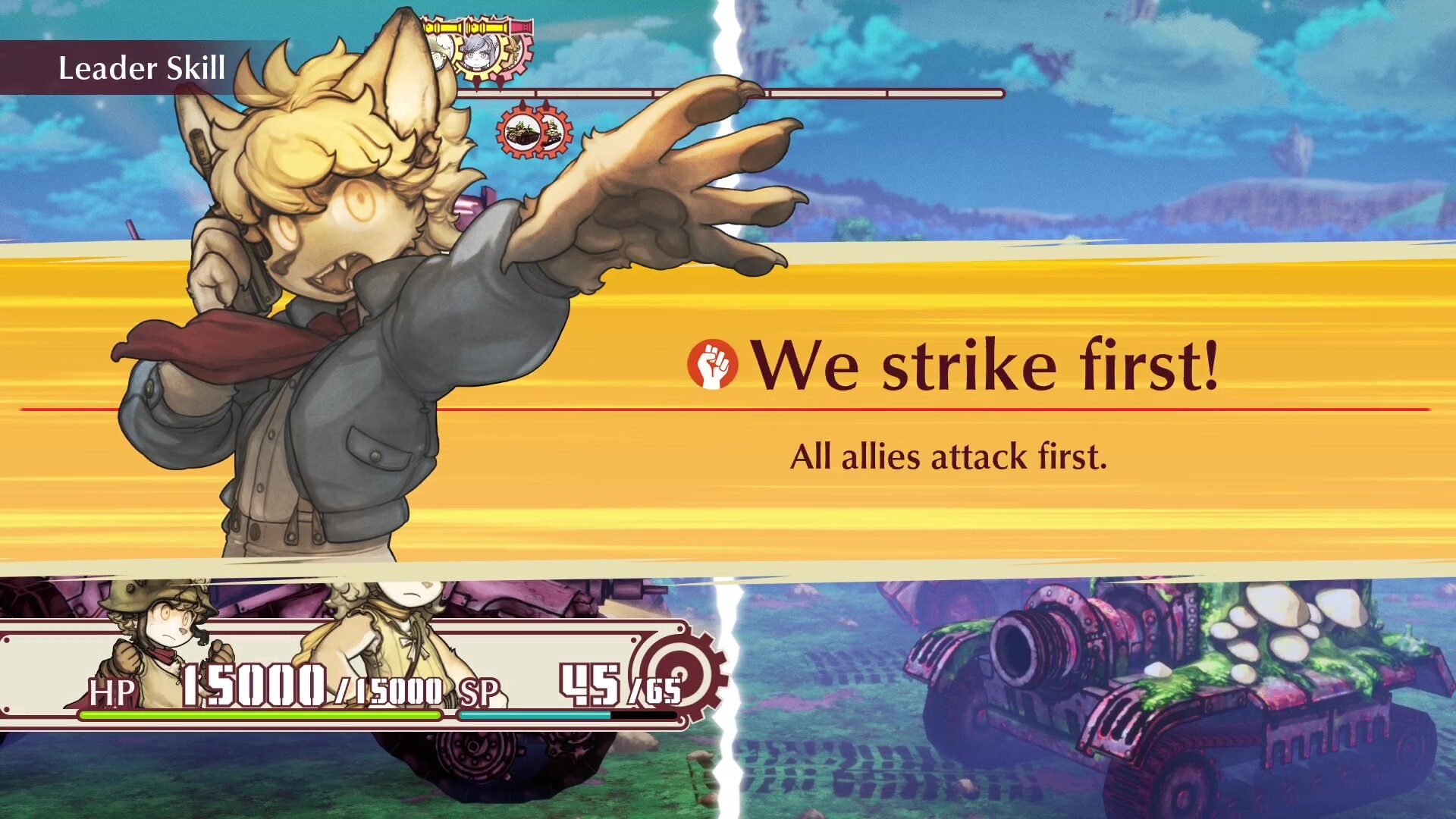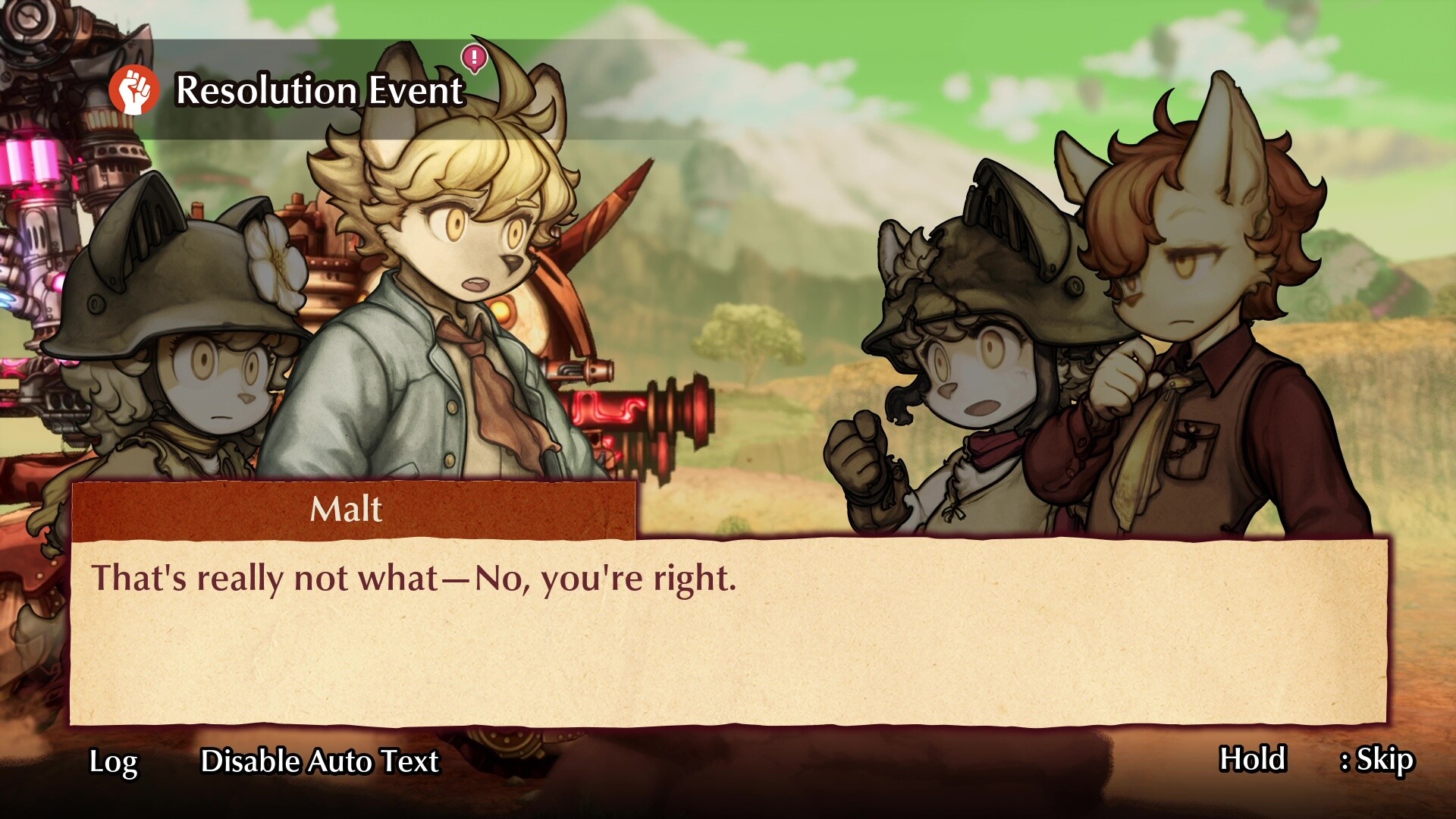Developer CyberConnect2 delivered a great tactical RPG in the form of Fuga: Melodies of Steel, and Fuga: Melodies of Steel 2 is a sequel that aims to solely placate fans of the original release. While this means that the game largely treads familiar ground in terms of mechanics with little room for something new, it’s still a pretty solid experience that should make for a fun time – albeit with a few flaws that we will discuss in further sections of this review.
Fuga: Melodies of Steel 2 picks up a year after the original game, where your band of furry fighters defeated the Berman Empire throughout the course of that adventure. If you’re like me and aren’t familiar with the original story, there is a helpful story recap that will get you up to speed on the essential characters and events through animated slides. As for the story in Melodies of Steel 2, the same gang of Children return once again as a new evil force takes hold of the Taranis tank and wreaks havoc across the entire realm – all while most of your friends are still imprisoned within that enemy tank.
The plot itself is pretty simple, and like the original – the characters take precedence over the narrative. The Children themselves remain adorable to look at, but there’s a lot of inconsistency between the many protagonists that form the entire crew. Most of them are returning characters from the original, but you will also find new crewmates including but not limited to Vanilla who will play an integral role in the journey. Malt is the eldest in the gang and assumes the role of the leader of the crew, and his character arc is pretty compelling in comparison to the other children – most of whom have annoying quirks and little in the name of actual personality.

“Conversations between the children are also pretty uninteresting and littered with hammy dialogue, and the atmosphere is established through descriptive paragraphs – and all that comes together to make a story that’s interesting on the whole but fails to keep you captivated on a moment-to-moment basis.”
In addition to this, the writing doesn’t feel natural as the style resembles more of what you’d find in a novel than a video game. Conversations between the children are also pretty uninteresting and littered with hammy dialogue, and the atmosphere is established through descriptive paragraphs – and all that comes together to make a story that’s interesting on the whole but fails to keep you captivated on a moment-to-moment basis. Part of this can be blamed on the over-reliance on anime caricatures, but couple that with a pretty slow start to things – and the story department definitely leaves something to be desired.
Fuga: Melodies of Steel 2 shares a lot of similarities to the original in terms of gameplay, and players will be once again controlling a battle tank as they make their way through arenas filled with enemy presence. Battles take place through a turn-based combat system where strategy and judicial use of resources is key to survival. The tank has three separate turrets, each manned by a crew member.
Each of the members has access to one of three weapon types (grenade launcher, machine gun, or cannon) alongside a slew of special abilities, and you have to juggle between different character combinations to be the most effective for any given enemy type. Choosing the right weapons for the right enemy also results in delayed status effects on enemies, which give you more opportunities to whittle down the health bars. For instance, aerial units are most vulnerable to machine guns while bigger ground troops are best dealt with using grenade launchers and cannons – and so on and so forth.

“Battles take place through a turn-based combat system where strategy and judicial use of resources is key to survival.”
Melodies of Steel 2 re-introduces the Soul Cannon mechanic which helps in adding a lot of tension to crucial boss battles. You see, the Soul Cannon is a powerful weapon that takes the soul of a soldier to unleash a devastating attack upon the enemy. In fights where your enemy is using the Soul Cannon, you need to take it out before a set number of turns else you run the risk of failing the fight entirely. And once you get a hold of that weapon, you need to keep your HP in check since the Cannon will automatically start its countdown if you reach a set critical level – which will eventually cause the battle to fail.
Sure, there is a bit of added frustration with the Soul Cannon constraints – but the game combats it with the Managarm which is another powerful weapon that’s available for use once per level. It knocks out a soldier for the entire duration of the level, but you deal a ton of damage to all the enemies in the arena as a result. Using it isn’t recommended unless absolutely necessary since you get robbed of all experience points after using the Managarm – so it’s more of an assist mode for those struggling to make it past certain sections.
Getting used to all these mechanics certainly has a learning curve, but it isn’t too steep such that it ends up being a frustrating endeavor. And once you get the basics down, it really feels good to absolutely obliterate the opposition with special attacks and careful usage of the right weapons. There are a ton of options at your disposal, and choosing the wisest of the bunch results in better combat ratings which net you more experience points for each character.

“Getting used to all these mechanics certainly has a learning curve, but it isn’t too steep such that it ends up being a frustrating endeavor.”
Each level consists of multiple paths to the objective, and there are points where you can choose between a safer option or risk engaging in more battles for better rewards by going with the normal route. You can also call Airship Support now to bomb certain enemies beforehand, buy crucial resources during mid-mission, or transport your tank to an alternate route which adds more flexibility and freedom of choice to the combat proceedings.
There are multiple Intermission areas between levels, which act as checkpoints to save your progress in the event that you fail a battle. This section allows you to take direct control of the Children, and navigate the ship to upgrade its arsenal or interact with crewmates. Forming meaningful relationships with your crewmates unlocks Link Attacks, which are powerful special moves that can be activated during battle to unleash some devastating blows to the enemy. But the conversations or Link Events that cause these bonds to get stronger are once again filled with uninteresting dialogue that makes getting through them an absolute slog. As such, I found myself skipping through these conversations as fast as possible which is a shame because it could have been so much better if carried out with quality writing.
Also worth noting is that you get a select number of Action Points for each Intermission, and everything from interactions to upgrades to farming and fishing for resources costs a point – which forces you to be tactical in prioritizing what to do now and what to leave for later. However, you can undo these decisions by choosing to restart from Before the Intermission after a game over if you’d like to re-evaluate your choices.
Apart from the Intermission, players can also take part in Expeditions which are mini-dungeons that are filled with all sorts of traps and valuables. The side-scrolling exploration and combat are pretty primitive in nature, but it’s a fun little distraction that keeps things fresh and breaks the rather monotonous flow of story and combat while also providing you with precious resources to constantly upgrade your weapons and tank facilities.
“Many of the assets and UI elements are almost identical to the original, which wouldn’t matter all that too much if you’re jumping in for the first time – but it would stick out to those who have spent dozens upon dozens of hours in Melodies of Steel.”
In between tackling levels, you will be visiting settlements where you can choose to shop for resources or talk to NPCs who will give you helpful tips for upcoming battles or just engage in simple conversations that always end with a dialogue choice. You get to choose from Empathy and Resolution, and these choices will get stacked against one another and eventually unlock your Leader Skills which are special buffs that are randomly activated during battles.
Speaking of the presentation, Fuga: Melodies of Steel 2 features the same cute and cuddly visuals that we saw in the original. Many of the assets and UI elements are almost identical to the original, which wouldn’t matter all that too much if you’re jumping in for the first time – but it would stick out to those who have spent dozens upon dozens of hours in Melodies of Steel. The somber music tracks also make a return, which helps create a soothing and melancholic atmosphere as you fight these gargantuan mechs in battle.
In conclusion, Fuga: Melodies of Steel 2 can best be described as more of the same – so if that description excites you, this sequel should be right up your alley. On the other hand, if you didn’t have a good time playing the original, it’s unlikely that Melodies of Steel 2 will change that viewpoint. But looking at it in a vacuum, Melodies of Steel 2 is a surprisingly solid tactical RPG that strikes a good balance between accessibility and skill. The story is hampered by weak writing and inconsistent characters, but apart from that there isn’t much to complain about.
This game was reviewed on the PlayStation 5.
Fuga: Melodies of Steel 2 Review – A Solid Time
Source: News Beginning

0 Comments